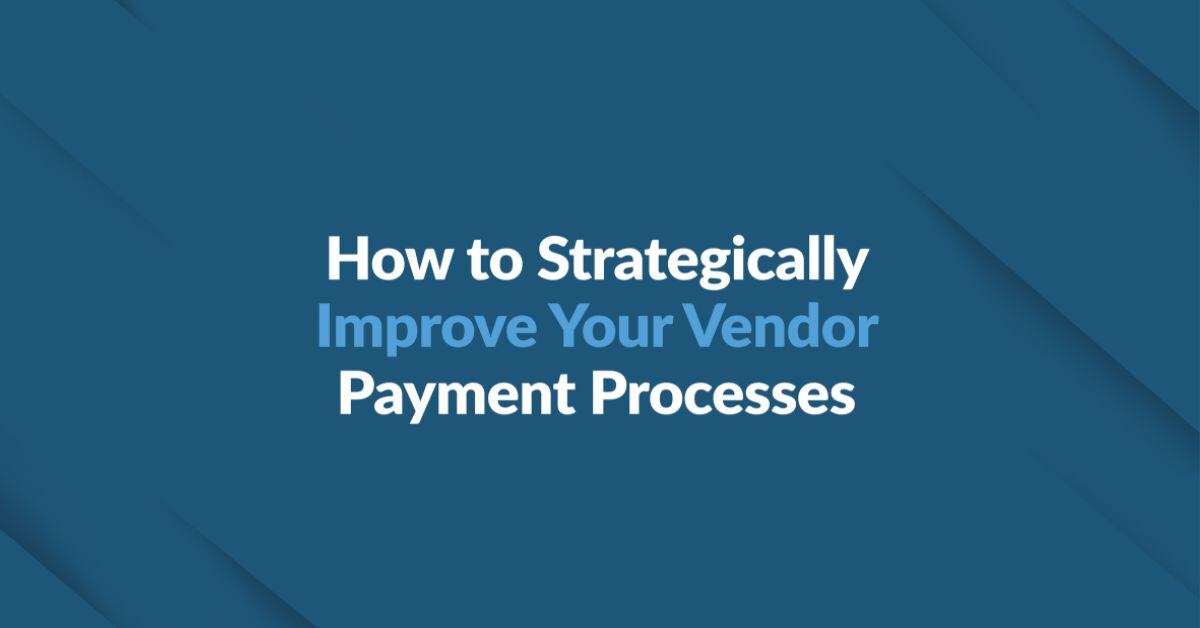Automated Accounts Receivable Programs: Cutting DSO by 30% in Six Months
In today’s economy, speed to cash is as important as speed to market. Companies that let receivables linger for 60, 75, or even 90 days are putting...
5 min read
September 26 2024
by
![]() Chris Cosgrove
Chris Cosgrove

No vendor wants to be left questioning the status of their payments, and AP automation is becoming a proven way to pay on time and improve vendor relationships.
Providing exceptional customer service is a core value for most businesses, but serving vendors well is another critical area that shouldn’t be overlooked. Maintaining good vendor relationships helps gain better service and support, more favorable payment terms, and opportunities for additional business relationships.
What’s concerning here, however, is that many B2B invoices don’t get paid on time. Atradius reported in 2023 that the businesses they surveyed experienced a 13% rise in late payments that year and over 50% of B2B invoices were late. For these reasons, now may be a good time to evaluate just where your vendor payment processes are at and what steps you should take to improve the quality of your operations. Continue reading to discover strategies you can use to improve your vendor payment process in your business.
Besides experiencing an abundance of late payments, businesses often have struggles related to manual invoice and payment processing, including the following:
Limited Visibility. When information is siloed across different departments or systems, it becomes challenging to track invoice statuses and payment approvals. Reliance on manual data entry, fragmented systems, and lack of real-time reporting tools are the biggest contributors and inadequate integration between accounting software and payment platforms further obscures the process. These factors combined contribute to inefficiencies, errors, and an overall lack of transparency in managing vendor payment processes.
Too Many Payment Methods. Handling various payment methods in accounts payable (paper checks, ACH, wire transfer, credit card) can complicate vendor payments, creating confusion and increasing the likelihood of errors. This complexity makes it harder to reconcile payments, leading to delays and missed deadlines. The added burden on AP teams to manage and track different methods can be overwhelming and cause inconsistent processing and duplicate payments. Such fragmentation disrupts vendor relationships, strains communication, and complicates overall cash flow management, ultimately impacting business operations negatively.
Poor Communication. Disorganized workflows, decentralized communication channels, and delayed responses due to inefficient invoice processing often lead to breakdowns in vendor relationships. When information is spread across multiple systems or departments, providing vendors with timely updates on payment statuses becomes challenging. Additionally, inconsistent follow-ups, unclear payment terms, and inadequate tracking of vendor inquiries contribute to misunderstandings. These factors create frustration and strain in vendor relationships, ultimately resulting in poor communication and disrupted business operations.
Efficient vendor payment processes are crucial for maintaining strong business relationships and ensuring smooth operations. Here, we’ll explore practical strategies to streamline your vendor payment processes, enhance accuracy, and build trust with your vendors. By implementing these approaches, you will not only begin improving your financial management but you’ll also begin ensuring timely, accurate payments that support long-term business success.
Assessing the effectiveness of your vendor relationships is crucial for enhancing payment processes and ensuring smooth operations. Begin by reviewing the vendor's performance against key metrics such as delivery timeliness, product or service quality, and adherence to contract terms. Consistent performance in these areas indicates a reliable partnership and helps in maintaining operational efficiency.
Examine the quality of communication with your vendors. Effective vendors should offer clear, timely updates and respond promptly to inquiries or issues. Evaluate how well they adhere to agreed payment terms and manage any disputes that arise. Good communication fosters trust and reduces the risk of misunderstandings that can disrupt payment processes.
Consider the financial stability of your vendors as well. Vendors with a solid financial foundation are less likely to encounter issues that could impact their service delivery. Reviewing the terms of your contracts periodically ensures they continue to meet your business needs and reflect current market conditions.
Additionally, gather feedback from your team members who interact with vendors regularly. Their insights can reveal areas for improvement and help address any potential issues. Regularly assessing these factors allows businesses to strengthen vendor relationships, streamline payment processes, and achieve more effective partnerships.
Implementing automation in accounts payable has the potential to significantly enhance vendor payment processes, leading to greater efficiency and accuracy. By digitizing invoice processing and payment workflows, businesses can streamline tasks that were previously manual and time-consuming. Automated systems ensure that invoices are matched with purchase orders and receipts, reducing the risk of errors and ensuring that payments are only made for valid, approved transactions.
Automation also improves visibility into the payment process. Real-time tracking and reporting allow businesses to monitor the status of invoices and payments, providing clarity and helping to prevent delays. This enhanced visibility helps in managing cash flow more effectively, as businesses can better predict and plan for upcoming expenses.
Another key benefit of automation is the reduction in manual data entry and associated errors. Automated systems can capture invoice data directly from electronic documents, minimizing the need for manual input and reducing the likelihood of mistakes that can lead to payment delays or discrepancies. This not only speeds up the processing time but also ensures that payments are accurate and on time.
It’s also worth noting that because automated systems often include built-in fraud detection features such as automated matching and approval workflows, identifying and preventing fraudulent activities becomes a much easier task. These systems can flag unusual transactions or discrepancies to enable prompt investigation and resolution before payments are issued.
Streamlining the vendor onboarding process is crucial for enhancing efficiency and ensuring smooth operations in your accounts payable department. Implementing a few key practices can significantly simplify this process, including:
By setting these practices into motion, businesses can streamline their vendor onboarding process, reducing administrative burdens, minimizing errors, and enhancing overall efficiency.
Transitioning from paper checks to electronic payment methods and negotiating payment terms can significantly enhance the vendor payment process, offering numerous benefits for both businesses and their vendors.
Shifting from paper checks to electronic payments streamlines the payment process by reducing the time and resources required for handling and processing physical checks. Electronic payments, such as ACH transfers, wire transfers, and virtual credit cards offer faster processing times and greater accuracy. This shift minimizes the risk of lost or delayed payments and allows for more efficient reconciliation of transactions. Electronic methods also enhance security by reducing the risks associated with handling physical checks, such as fraud or theft.
Negotiating favorable payment terms with vendors is equally important. By discussing and agreeing on terms such as payment deadlines and flexible payment schedules, businesses can improve their cash flow management and strengthen relationships with vendors. Flexible terms also help manage cash flow more effectively and allow businesses to align payments with their financial cycles.
Virtual credit cards, a type of electronic payment method, provide a secure and efficient way to handle payment transactions. These cards generate unique card numbers for each purchase, therefore reducing the risk of fraud and giving a business better control over spending. As a result, vendors receive payments faster and with greater security.
The adoption of virtual credit cards also streamlines payment processing since vendors can receive payments directly into their accounts without the delays associated with physical checks or the administrative burden of processing them.
Additionally, using virtual credit cards comes with financial incentives for businesses. Many credit card providers offer cash rebates or rewards for transactions made with their cards, and by channeling payments through virtual credit cards, businesses can accumulate these rewards and turn everyday transactions into a source of additional revenue. Over time, these rebates contribute to cost savings and help improve a business’s overall financial performance.
Working with an AP automation provider like CloudX is the best way to begin transforming the mechanics behind your vendor payment processing. Not only will get support exploring communications with your vendors, but you will also be guided through the process of automating your invoice and payment processing to meet you business’s unique requirements.
For more information about CloudX’s APSmart and PAYSmart, please fill out our online form here.

In today’s economy, speed to cash is as important as speed to market. Companies that let receivables linger for 60, 75, or even 90 days are putting...

Managing operational costs today often means balancing operational costs against tight margins, making it essential to join a group purchasing...